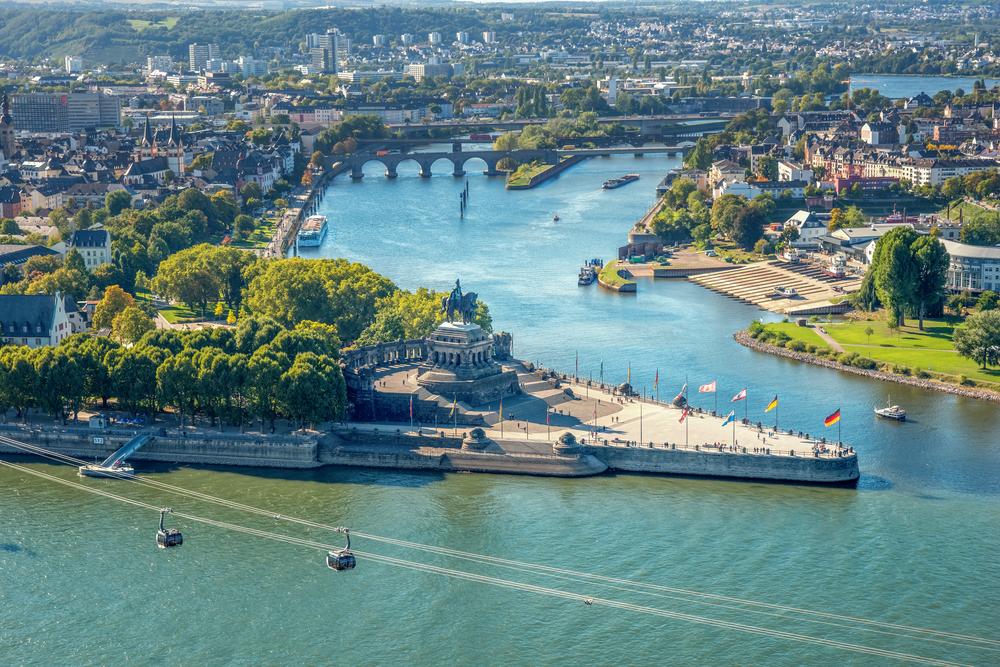At the confluence of the Rhine and Moselle, in the heart of Europe, the unique location was both fate and stroke of luck. In its almost 2000-year-old history, Koblenz has seen foreign armies come and go. The Romans secured their sphere of influence through forts, Franks built a royal court, electors’ theatre, castle and castle. In 1690, Koblenz became an electoral residence.
To visit the sights of Koblenz, we recommend spending the night at one of the beautiful campsites on the Moselle.
At the mouth of the Moselle, located on the Rhine
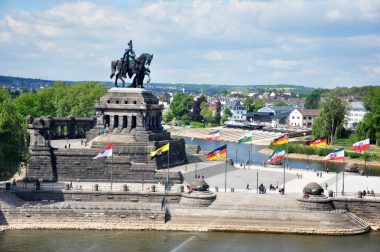
Koblenz forms the centre of the Middle Rhine Valley at the mouth of the Moselle. Originally, the city was not oriented towards the Rhine, but towards the Moselle. The oldest historic buildings can be found on the rivers: on the Moselle the Electoral Trier castle from the 13th century with the Balduin Bridge, on the Rhine the Romanesque church of St. Castor and the classicist residential castle of the Trier archbishops.
The Moselle city on the Rhine has survived and used numerous conquests – the diversity of cultural influences merged into a pleasant unity: Rhenish wine taverns stand on Roman foundations – Prussian virtues and French way of life flowed together. On the rivers, at the intersection of all military roads, the former fort has succeeded in building a bridge to the lovable city.
Koblenz – Discoveries on Old Town Paths
The old town of Koblenz is located directly on the Moselle. Already from Eltzerhofstraße you dive into the picturesque old town districts, which enchant in a confusing labyrinth. It doesn’t matter which alley you enter first. The alley “Unterm Stern” with the former harbour master’s office is particularly atmospheric.
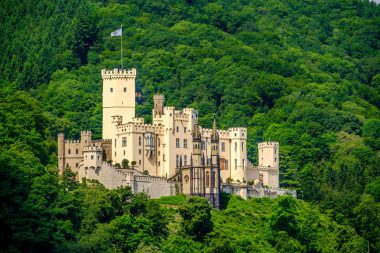
Again and again, the Balduin Bridge, which Elector Baldwin built in 1340 on Roman foundations, pushes itself into the picture. On the way to the old town, you first pass the residential tower-like inn “Deutscher Kaiser”. The residential tower, built at the beginning of the 16th century, is crowned by a crenellated wreath. It is the oldest inn in the city with a beautiful late Gothic vault and at the same time the only building that survived the destruction of the war. Further west is the impressive Florinskirche, built around the year 1100. It did not receive its Gothic choir until the 15th century. In the immediate vicinity is the Middle Rhine Museum, which is housed in the old “Kauf- und Danzhaus”. The highest point of the old town is occupied by the Romanesque Church of Our Lady, which the locals affectionately call “Owerpfarrkerch”. Supported by the foundation walls of a Roman hall building from the 6th century, it is considered the actual original church of the settlement.
Soon you reach the Münzplatz, which is reminiscent of the electoral mint with the former residence (1763) of the mint master Meydinger.
The lively square is the urban heart of Koblenz. Pretty restaurants, cafés, quaint pubs and traditional pubs line the square and invite you to linger.
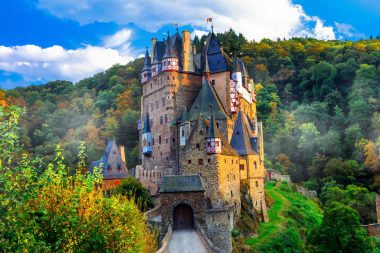
East of the old town is the secret landmark of the city. On Jesuitenplatz are the Jesuit Church, rebuilt in 1959, and the town hall (1695-1700), in front of which the snake fountain stands. With the depiction of the meandering, the Koblenz rascal, a monument to the joy of life was erected, so to speak.
What would Koblenz be without its gruesome stories? Under the tower clock of the house on Florinsmarkt, the figure of the eye roller is reminiscent of the robber baron Johann Lutter von Kober.
If you ask the Koblenz resident about the strange grimace at the “Kauf- und Danzhaus”, visitors will hear a creepy story: When the robber baron and villain was to be beheaded, he is said to have told the judges and spectators what he thought of the verdict by horribly rolling his eyes and sticking out his tongue. He looked just like the one who makes his faxes under the tower clock today. This spectacle can be experienced every hour on the hour and half an hour.
Deutsches Eck – Moselstraße on the Rhine
“A punch made of stone” is what Tucholsky called the equestrian statue at the Deutsches Eck in 1930. In 1897, the monument to Kaiser Wilhelm I was unveiled on the headland. Shot to death at the end of the war, the emperor is now riding again. The name “Deutsches Eck” originally refers only to a branch of the Teutonic Order. To the south is the former collegiate church of St. Kastor. The basilica is the oldest surviving church in Koblenz. Founded in 836, its current form was created in the 12th century. The Romanesque church houses valuable paintings on the vaulted ceiling and offers a high level of artistic enjoyment.
Ehrenbreitstein Fortress
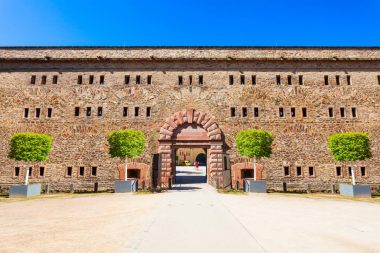
Opposite the Deutsches Eck is the Ehrenbreitstein Fortress with a beautiful view of the rivers and the old town of Koblenz. It rises mightily 118 meters high on steeply sloping slate rocks above the city. The former knight’s castle now serves as a museum and youth hostel. Under the Prussians, the castle had great strategic importance until the 19th century. During their reign, it received its present form.
One of the highlights is the spectacular cable car over the Rhine. This leads to Ehrenbreitstein Fortress and offers a breathtaking view over the upper Middle Rhine Valley.
Rhine in Flames – Silver Spinning Tops, Fire Flowers and Luminous Comets
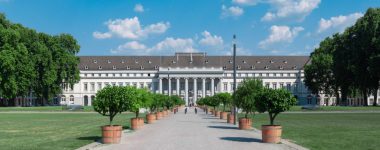
Every year on the second Saturday in August, the “Rhine in Flames” presents itself. The spectacle, which is unique in Germany , is the oldest fireworks event on the Rhine. More than half a million people gather when the grandiose fire magic takes its course. However, there is nothing to quench for the many visitors – at most the thirst for the local Riesling wine.
Tip: Not far from Koblenz, Stolzenfels Castle towers high above the Rhine. This romantic castle complex was built in the 13th century, but destroyed by the French in 1689. The reconstruction took place in 1836-42 by Karl-Friedrich Schinkel. The Prussian holiday residence full of Italian cheerfulness and Bavarian-English castle romance attracts visitors in droves.
Popular museums in Koblenz
- Landesmuseum Koblenz: The Landesmuseum Koblenz is an archaeological museum that deals with the history and culture of the region. It is located in the Ehrenbreitstein Fortress and has an extensive collection of artifacts from Roman times to the present day.
- Middle Rhine Museum: The Middle Rhine Museum is an art history museum that specializes in the art and culture of the Middle Rhine Valley. It houses a collection of paintings, sculptures, and other artworks from the region.
- House of Photography of the State of Rhineland-Palatinate: The House of Photography of the State of Rhineland-Palatinate is a museum for photography and contemporary art. It shows exhibitions by national and international photographers as well as works by contemporary artists.
- Romanticum: The Romanticum is an interactive museum dedicated to Romanticism in the Rhineland. It offers a multimedia experience with exhibitions, films and interactive installations.
- Deutsches Eck Museum: The Deutsches Eck Museum is a small museum near the Deutsches Eck. It shows the history of the Deutsches Eck and the city of Koblenz.
Attractions near Koblenz
- Deutsches Eck: A headland at the confluence of the Rhine and Moselle rivers with the Kaiser Wilhelm Monument.
- Ehrenbreitstein Fortress: A fortress on a hill above Koblenz with a great view of the city and the Rhine.
- Stolzenfels Castle: A neo-Gothic castle from the 19th century in Koblenz-Stolzenfels.
- Eltz Castle: A medieval castle located about an hour from Koblenz.
- Marksburg: One of the few medieval castles on the Rhine that was never destroyed and now serves as a museum.
- Lahneck Castle: A castle in Lahnstein that is also used as a museum.
- Rheinsteig: A hiking trail along the Rhine with breathtaking views of the surrounding landscape.
- Moselle Cycle Path: A cycle path along the Moselle that passes many picturesque villages and vineyards.
- Andernach Geyser: The highest cold-water geyser in the world, which erupts regularly and creates an impressive water fountain.
Facts about Koblenz
- Koblenz is located at the confluence of the Rhine and Moselle rivers and is therefore also known as the “Deutsches Eck”.
- The city has a long history, dating back to Roman times. Some remnants from this period can still be seen, including the Roman theatre.
- Koblenz suffered greatly in the Second World War and was largely destroyed. However, many of the historic buildings have been rebuilt.
- One of the most famous sights in Koblenz is the Ehrenbreitstein Fortress, which towers high above the city. It was built in the 19th century and is now a museum and cultural center.
- Every year, Koblenz hosts the famous wine festival, which attracts thousands of visitors from all over the world.
- The city is also an important transport hub, as the A48 and A61 motorways and the B9 and B49 federal roads come together here.
- Koblenz is also known for its beautiful old town with its narrow streets and old half-timbered houses.
- Another well-known attraction is Stolzenfels Castle, which was rebuilt in the 19th century in the neo-Gothic style and now serves as a museum.
- There is also a university in Koblenz, the University of Koblenz-Landau, with a wide range of courses of study.
- The city is also an important location for the Bundeswehr, as the Center for Innere Führung and the Training Center for Catering and Supply of the Bundeswehr are located here.


